The Smart Stadium Market is estimated to be valued at USD 20.7 billion in 2025 and is projected to reach USD 79.5 billion by 2035, registering a compound annual growth rate (CAGR) of 14.4% over the forecast period.
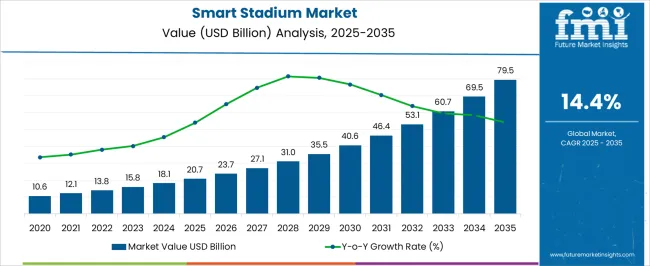
| Metric | Value |
|---|---|
| Smart Stadium Market Estimated Value in (2025 E) | USD 20.7 billion |
| Smart Stadium Market Forecast Value in (2035 F) | USD 79.5 billion |
| Forecast CAGR (2025 to 2035) | 14.4% |
The Smart Stadium market is experiencing notable growth, driven by increasing investments in technology-enabled sports and entertainment facilities that enhance fan engagement, safety, and operational efficiency. Rising adoption of digital solutions such as IoT sensors, AI-powered analytics, and real-time monitoring platforms is enabling stadium operators to improve crowd management, optimize resource allocation, and deliver personalized fan experiences. The integration of smart lighting, connected seating, and mobile applications is further enhancing the overall stadium experience.
Growing demand for enhanced security measures, operational efficiency, and energy management is motivating stadium owners to implement intelligent solutions. Cloud-based and on-premises deployment options allow organizations to select systems that align with operational requirements and budget constraints.
Additionally, the rise of sports tourism, international events, and multi-purpose stadium use is accelerating market adoption As stadium operators prioritize scalable, data-driven solutions to improve revenue streams, fan engagement, and operational management, the Smart Stadium market is expected to witness sustained growth over the coming decade.
The smart stadium market is segmented by solution, deployment, and geographic regions. By solution, smart stadium market is divided into Software, Digital Content Management, Stadium & Public Security, Building Automation, Event Management, Network Management, Crowd Management, Services, Professional Services, Consulting, Deployment & Integration, Support & Maintenance, and Managed Services. In terms of deployment, smart stadium market is classified into On-Premises and On-Cloud. Regionally, the smart stadium industry is classified into North America, Latin America, Western Europe, Eastern Europe, Balkan & Baltic Countries, Russia & Belarus, Central Asia, East Asia, South Asia & Pacific, and the Middle East & Africa.
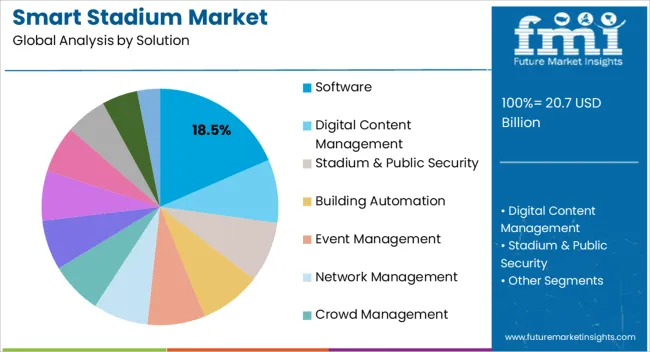
The software solution segment is projected to hold 18.5% of the Smart Stadium market revenue in 2025, establishing it as a leading component type. Growth is being driven by the increasing adoption of intelligent platforms that enable real-time monitoring, analytics, and integration with stadium infrastructure. Software solutions facilitate operational management, fan engagement, and security monitoring without requiring extensive hardware upgrades.
These platforms allow stadium operators to implement AI-powered crowd control, ticketing analytics, and predictive maintenance, improving efficiency and minimizing operational risks. Integration with mobile applications and IoT devices enhances the delivery of personalized experiences to spectators while ensuring safety and compliance with regulatory standards.
The ability to scale software solutions across multiple facilities and upgrade functionalities through updates without major capital expenditure further supports adoption As stadium operators seek enhanced operational efficiency, improved fan experiences, and actionable insights from large volumes of data, the software solution segment is expected to maintain a strong position in the market, supported by innovation and digital transformation initiatives.
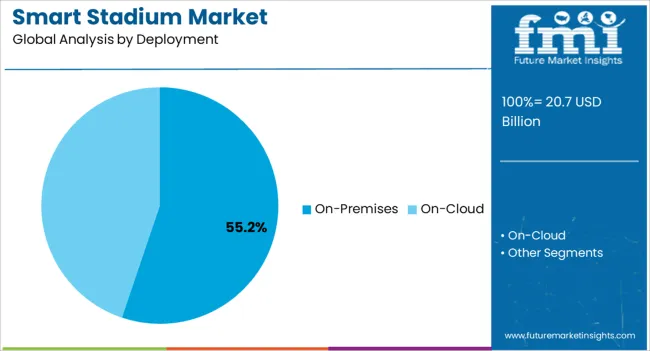
The on-premises deployment segment is anticipated to account for 55.2% of the Smart Stadium market revenue in 2025, making it the leading deployment model. Its growth is driven by the need for greater control over sensitive operational data, network security, and compliance with regulations governing large venues.
On-premises deployment enables organizations to integrate existing IT infrastructure, reduce latency for real-time analytics, and ensure uninterrupted operations during high-demand events. The ability to customize software and hardware solutions according to the unique layout, capacity, and operational requirements of stadiums enhances the adoption of on-premises systems.
Additionally, this deployment approach allows seamless integration with security monitoring, ticketing, and facility management platforms, providing operators with centralized control and real-time decision-making capabilities As demand for high-performance, reliable, and secure smart stadium solutions increases, on-premises deployment is expected to remain the preferred choice for operators who prioritize data sovereignty, operational efficiency, and customization, reinforcing its leading revenue share in the market.
From last couple of decades, stadiums have seen increasing demand from sports and entertainment sector. The increasing demand, in turn, increases the number of viewers in the stadium.
Crowd management is the major factor of concern for the stadium managers. The introduction of a smart stadium, curtail many of these problems.
Generally, a smart stadium comprises of a large number of sensors, cameras, and digital signs, which are being connected to wired and wireless networks and servers.These sensors provide real-time information about empty parking spots, waiting lines, a number of vacant seats and other useful information.
Additionally, with the help of advanced technology, the smart stadium now can predict the uncertain whether condition and provide early planning of entry and exit point in case of any chaos.Moreover, viewers now can order their meals by seating on their seats, with the help of their smartphones by connecting it to stadium server.
The number of advantages coupled with safety and security provided by smart stadium has led increasing demand for smart stadium and is expected to show significant growth over the forecast period.
Advanced technologies and increasingly digital world is forcing the sports industry and sport stadiums to adapt Internet of Things (IoT) and this adoption can bridge gap between digital space and the physical world.
Teams are focusing on few main areas to utilize IoT in today’s world to address specific needs or challenges. Integration of IoT in smart stadiums increases the revenue streams, enhance fan experience, provide real-time personalization and increase venue efficiency.
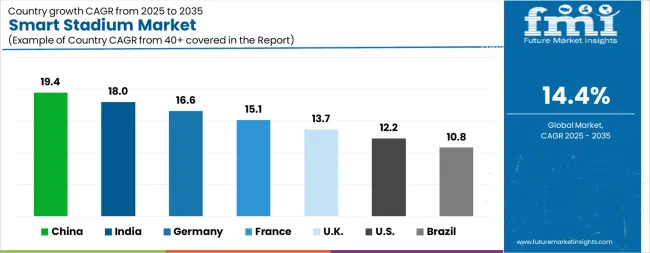
| Country | CAGR |
|---|---|
| China | 19.4% |
| India | 18.0% |
| Germany | 16.6% |
| France | 15.1% |
| UK | 13.7% |
| USA | 12.2% |
| Brazil | 10.8% |
The Smart Stadium Market is expected to register a CAGR of 14.4% during the forecast period, exhibiting varied country level momentum. China leads with the highest CAGR of 19.4%, followed by India at 18.0%. Developed markets such as Germany, France, and the UK continue to expand steadily, while the USA is likely to grow at consistent rates. Brazil posts the lowest CAGR at 10.8%, yet still underscores a broadly positive trajectory for the global Smart Stadium Market. In 2024, Germany held a dominant revenue in the Western Europe market and is expected to grow with a CAGR of 16.6%. The USA Smart Stadium Market is estimated to be valued at USD 7.6 billion in 2025 and is anticipated to reach a valuation of USD 24.2 billion by 2035. Sales are projected to rise at a CAGR of 12.2% over the forecast period between 2025 and 2035. While Japan and South Korea markets are estimated to be valued at USD 1.0 billion and USD 718.6 million respectively in 2025.
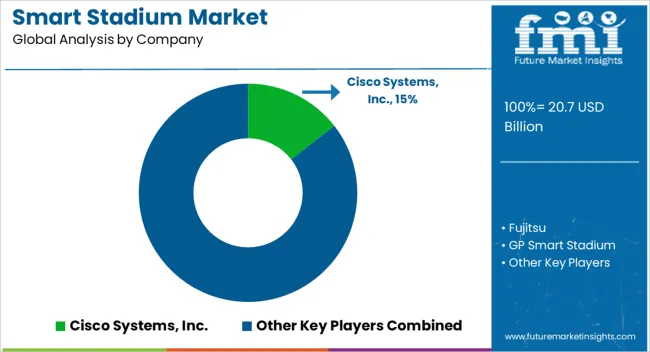
| Item | Value |
|---|---|
| Quantitative Units | USD 20.7 Billion |
| Solution | Software, Digital Content Management, Stadium & Public Security, Building Automation, Event Management, Network Management, Crowd Management, Services, Professional Services, Consulting, Deployment & Integration, Support & Maintenance, and Managed Services |
| Deployment | On-Premises and On-Cloud |
| Regions Covered | North America, Europe, Asia-Pacific, Latin America, Middle East & Africa |
| Country Covered | United States, Canada, Germany, France, United Kingdom, China, Japan, India, Brazil, South Africa |
| Key Companies Profiled | Cisco Systems, Inc., Fujitsu, GP Smart Stadium, Huawei Technologies Co., Ltd., IBM Corporation, Intel Corporation, Mapsted Corp., NEC Corporation, Johnson Controls, NXP Semiconductors, Schneider Electric, Telefonaktiebolaget LM Ericsson, and CommScope Holding Company, Inc |
The global smart stadium market is estimated to be valued at USD 20.7 billion in 2025.
The market size for the smart stadium market is projected to reach USD 79.5 billion by 2035.
The smart stadium market is expected to grow at a 14.4% CAGR between 2025 and 2035.
The key product types in smart stadium market are software, digital content management, stadium & public security, building automation, event management, network management, crowd management, services, professional services, consulting, deployment & integration, support & maintenance and managed services.
In terms of deployment, on-premises segment to command 55.2% share in the smart stadium market in 2025.






Our Research Products

The "Full Research Suite" delivers actionable market intel, deep dives on markets or technologies, so clients act faster, cut risk, and unlock growth.

The Leaderboard benchmarks and ranks top vendors, classifying them as Established Leaders, Leading Challengers, or Disruptors & Challengers.

Locates where complements amplify value and substitutes erode it, forecasting net impact by horizon

We deliver granular, decision-grade intel: market sizing, 5-year forecasts, pricing, adoption, usage, revenue, and operational KPIs—plus competitor tracking, regulation, and value chains—across 60 countries broadly.

Spot the shifts before they hit your P&L. We track inflection points, adoption curves, pricing moves, and ecosystem plays to show where demand is heading, why it is changing, and what to do next across high-growth markets and disruptive tech

Real-time reads of user behavior. We track shifting priorities, perceptions of today’s and next-gen services, and provider experience, then pace how fast tech moves from trial to adoption, blending buyer, consumer, and channel inputs with social signals (#WhySwitch, #UX).

Partner with our analyst team to build a custom report designed around your business priorities. From analysing market trends to assessing competitors or crafting bespoke datasets, we tailor insights to your needs.
Supplier Intelligence
Discovery & Profiling
Capacity & Footprint
Performance & Risk
Compliance & Governance
Commercial Readiness
Who Supplies Whom
Scorecards & Shortlists
Playbooks & Docs
Category Intelligence
Definition & Scope
Demand & Use Cases
Cost Drivers
Market Structure
Supply Chain Map
Trade & Policy
Operating Norms
Deliverables
Buyer Intelligence
Account Basics
Spend & Scope
Procurement Model
Vendor Requirements
Terms & Policies
Entry Strategy
Pain Points & Triggers
Outputs
Pricing Analysis
Benchmarks
Trends
Should-Cost
Indexation
Landed Cost
Commercial Terms
Deliverables
Brand Analysis
Positioning & Value Prop
Share & Presence
Customer Evidence
Go-to-Market
Digital & Reputation
Compliance & Trust
KPIs & Gaps
Outputs
Full Research Suite comprises of:
Market outlook & trends analysis
Interviews & case studies
Strategic recommendations
Vendor profiles & capabilities analysis
5-year forecasts
8 regions and 60+ country-level data splits
Market segment data splits
12 months of continuous data updates
DELIVERED AS:
PDF EXCEL ONLINE
Smart Meeting Pod Market Size and Share Forecast Outlook 2025 to 2035
Smart Electrogastrogram Recorder Market Size and Share Forecast Outlook 2025 to 2035
Smart Aerial Work Robots Market Size and Share Forecast Outlook 2025 to 2035
Smart Bladder Scanner Market Size and Share Forecast Outlook 2025 to 2035
Smart School Bus Platform Market Size and Share Forecast Outlook 2025 to 2035
Smart Home Wireless Smoke Detector Market Size and Share Forecast Outlook 2025 to 2035
Smart Bus Platform Market Size and Share Forecast Outlook 2025 to 2035
Smart Vision Processing Chips Market Size and Share Forecast Outlook 2025 to 2035
Smart Touch Screen Scale Market Size and Share Forecast Outlook 2025 to 2035
Smart Magnetic Drive Conveyor System Market Size and Share Forecast Outlook 2025 to 2035
Smart Wheelchair market Size and Share Forecast Outlook 2025 to 2035
Smart Mining Technologies Market Size and Share Forecast Outlook 2025 to 2035
Smart Parking Market Size and Share Forecast Outlook 2025 to 2035
Smart Digital Valve Positioner Market Forecast and Outlook 2025 to 2035
Smart Card IC Market Size and Share Forecast Outlook 2025 to 2035
Smart-Tag Inlay Inserters Market Analysis - Size and Share Forecast Outlook 2025 to 2035
Smart TV Market Forecast and Outlook 2025 to 2035
Smart/AI Toy Market Size and Share Forecast Outlook 2025 to 2035
Smart Locks Market Size and Share Forecast Outlook 2025 to 2035
Smart Sprinkler Controller Market Size and Share Forecast Outlook 2025 to 2035

Thank you!
You will receive an email from our Business Development Manager. Please be sure to check your SPAM/JUNK folder too.
Chat With
MaRIA